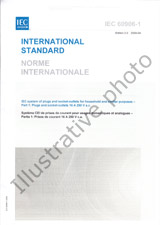We need your consent to use the individual data so that you can see information about your interests, among other things. Click "OK" to give your consent.

IEC 61300-3-4-ed.4.0
Fibre optic interconnecting devices and passive components - Basic test and measurement procedures - Part 3-4: Examinations and measurements - Attenuation
Translate name
STANDARD published on 9.5.2023
The information about the standard:
Designation standards: IEC 61300-3-4-ed.4.0
Publication date standards: 9.5.2023
SKU: NS-1143002
The number of pages: 45
Approximate weight : 135 g (0.30 lbs)
Country: International technical standard
Category: Technical standards IEC
The category - similar standards:
Annotation of standard text IEC 61300-3-4-ed.4.0 :
IEC 61300-3-4: 2022 describes the various methods available to measure the attenuation of optical components. It is not, however, applicable to random mate attenuation measurements as described in IEC 61300-3-34 and IEC 61300-3-45 nor for attenuation measurements of dense wavelength division multiplexing (DWDM) devices as described in IEC 61300-3-29. This fourth edition cancels and replaces the third edition published in 2012. This edition constitutes a technical revision. This edition includes the following significant technical changes with respect to the previous edition: a) addition of Clause 3 containing terms, definitions and abbreviated terms; b) addition of a new LSPM measurement method, insertion method (D); c) addition of Annex A describing attenuation measurement of multicore fibre; d) changed reference test method to insertion C and alternative test method to substitution or insertion D for power meter and type 4 DUT. The contents of the corrigendum of June 2023 have been included in this copy. LIEC 61300-3-4:2023 decrit les differentes methodes disponibles qui permettent de mesurer l’affaiblissement des composants optiques. Toutefois, elle n’est applicable ni aux mesurages de l’affaiblissement du a l’accouplement aleatoire decrits dans l’IEC 61300-3-34 et l’IEC 61300-3-45 ni aux mesurages de l’affaiblissement des dispositifs de multiplexage par repartition en longueur d’onde a forte densite (DWDM - dense wavelengths division multiplexer) decrits dans l’IEC 61300-3-29. Cette quatrieme edition annule et remplace la troisieme edition parue en 2012. Cette edition constitue une revision technique. Cette edition inclut les modifications techniques majeures suivantes par rapport a ledition precedente: a) ajout de l’Article 3 relatif aux termes, definitions et abreviations; b) ajout dune nouvelle methode de mesure LSPM, la methode par insertion (D); c) ajout de l’Annexe A qui decrit le mesurage de laffaiblissement de la fibre multicour; d) modification de la methode dessai de reference par insertion C et de la methode dessai alternative par substitution ou par insertion D pour l’appareil de mesure de la puissance et le DUT de type 4. Le contenu du corrigendum de juin 2023 a ete pris en consideration dans cet exemplaire.
These corrections apply to this standard:
Corrigendum 1 - Fibre optic interconnecting devices and passive components - Basic test and measurement procedures - Part 3-4: Examinations and measurements - Attenuation
(Corrigendum 1 - Dispositifs d´interconnexion et composants passifs fibroniques - Procedures fondamentales d’essais et de mesures - Partie 3-4: Examens et mesures - Affaiblissement)
Correction published on 28.6.2023
Selected format:Show all technical information.
We recommend:
Technical standards updating
Do you want to make sure you use only the valid technical standards?
We can offer you a solution which will provide you a monthly overview concerning the updating of standards which you use.
Would you like to know more? Look at this page.



 Cookies
Cookies
